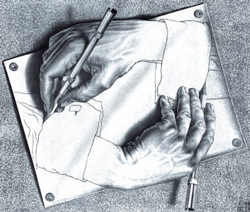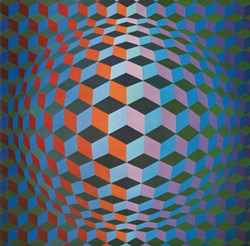| Search Art Prints | ||||||||||||||||||||
| Search Artists | ||||||||||||||||||||

|
||||||||||||||||||||
|
|
|||||||||||||||||||

Optical Illusion Art: Is what you get really what you see?
Optical Illusion Art: Is what you get really what you see?
Optical illusion art, also known as op art, is a mathematically-based genre that produces optical illusions. It uses the repetition of form and color to create moiré patterns that give rise to illusions. It also distorts our sense of depth, causing foreground-background confusion, as well as other perplexing effects.
Optical illusion art requires math ingenuity, technical skills and meticulous planning. Because it manipulates the rules of perception, a viewer trying to decipher such a painting may observe movement, hidden images, three-dimensional forms, and other simulation.
History of Optical Illusion Art
In October 1964, Time Magazine first used the term “optical art” in an article that referred to illusionary painting as a new type of art, when, in fact, works in this style had already been produced 30 years prior. One such artwork is the 1938 painting entitled ‘Zebras’ by Victor Vasarely, whom many consider to be the pioneer of this abstract movement. Other artists such as Bridget Riley, Jesus-Rafael Soto, Richard Anuszkiewicz, and Francois Morellet also created images that could be categorized as op art. MC Escher experimented with op art, though his work was not viewed as being completely abstract (http://www.aaronartprints.org/escher-drawinghands.php)
of this abstract movement. Other artists such as Bridget Riley, Jesus-Rafael Soto, Richard Anuszkiewicz, and Francois Morellet also created images that could be categorized as op art. MC Escher experimented with op art, though his work was not viewed as being completely abstract (http://www.aaronartprints.org/escher-drawinghands.php)
How to Create Optical Illusion Art
All the elements used to produce an illusionary piece, lines, shapes, and colors, must be carefully selected in order for their combination to reach the intended maximum effect. .
There are two main methods of producing op art. The first, and perhaps most commonly recognized method, is with the use of lines and pattern, often in black and white, which bring about illusionary images. The second is with color, using the same elements of pattern, but resulting in additional effects on the viewer’s eye and producing a different dimension.

There are three kinds of color interaction:
• Simultaneous contrast – it occurs when one area of color is surrounded by another color to create a difference in brightness, but when one area of color is larger and/or more intense than the other, the contrast is out of balance, appearing to be going in only one direction.
• Successive contrast – it occurs when one color is immediately followed by another color, quickly changing the viewer’s focus from one area of color to the other.
• Reverse contrast – it occurs when the lightness of white, or the darkness of black, seem to be spreading into neighboring regions, causing colors to appear to be spreading into one another.
Characteristics of Optical Illusion Art
Like all other genres or movements, optical illusion art has recognizable characteristics:
• It fools the eye in various ways. It can give a viewer the feeling or illusion that the image they are looking at is actually moving and/or multi-dimensional. Although a viewer is well aware that the image is fixed and flat, a different message is sent to the brain.
• It is non-representational because it is geometrically-based in nature.
• It employs two techniques to create optical illusions: perspective and juxtaposition of color, either chromatic or achromatic.
• It requires that the positive and negative space share equal attention in order to produce an image that functions properly.
In 1965, a major exhibition called “The Responsive Eye” truly captured the public’s interest and popularized the movement. As a result, op art began to appear everywhere: in print ads, television advertising, album covers, and even in the fashion world.
Donovan Gauvreau
Art Historian, Donovan Gauvreau lectures about art therapy with a focus on creativity development. He believes we can learn from the great masters in art to communicate ideas and feelings through painting. He provides content for www.AaronArtPrints.org to educate and inspire people to take a glimpse into an artist's life to better understand the meaning behind their work.











